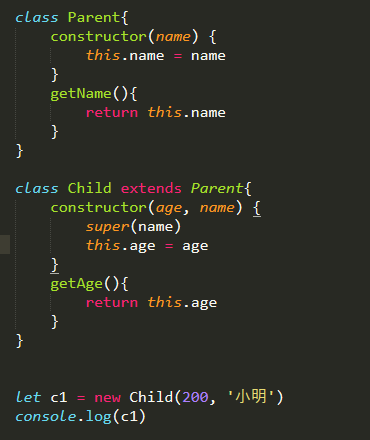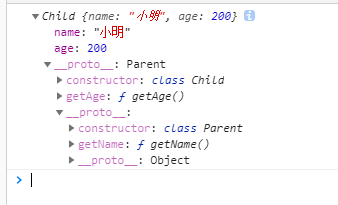
本文从以下几个方面着手
- 0怎么理解面向对象
- 1创建对象的方式
- 2记住原型链的小窍门
- 3instanceof 模拟实现
- 4new关键字 模拟实现
- 5继承的实现(逐步实现)
0 怎么理解面向对象
其实我也不知道咋回答这问题,我只知道,面试官问这个后,就表示他要问一堆继承的问题了。下面是引用周老师的一段说辞。
"面向对象是一种编程思想 与面向过程是对应的 一般的语言都是面向对象的 js本身也是基于面向对象构建出来的 ,例如 js本身就有很多内置类,Promise就是,可以new Promise来创建一个实例,来管理异步编程 。 还有vue 也是,平时都是创建vue的实例啊。"
1 创建对象的方式
1.对象字面量
var o1 = {name: 'o1'}
var o2 = new Object({name: 'o2'})
2.通过构造函数
var M = function(name){
this.name = name
}
var o3 = new M('o3')
3.Object.create
var o4 = Object.create(p)
2 记住原型链的小窍门
记忆总是有规律的,如高中时期学的三角函数,需要背公式很多,强行去背全部的公式是容易混乱的。不过如果把核心的几点背牢,其余的公式只需要稍加推导即可。关于原型链也是一样,有几点在最开始就记住的话,后面就不会乱了。原型链中关键概念:构造函数 ,实例, constructor ,__ proto__ ,prototype, 首先要记住他们的关系
- 实例(对象)有__proto__ , 实例(对象)没有prototype
- 构造函数有 prototype ,同时prototype又是对象,那么prototype即满足上面一条,除了拥有__proto__外,还含有constructor
- 构造函数的prototype的constructor就是指向构造函数本身,即上例子中 M.prototype.constructor === M
上面3点请先牢记,后面所总结的完整继承和这有紧密的关联
其实 构造函数, 实例, constructor, __ proto__, prototype 的关系已经在上面的例子和3点介绍中介绍完了。不妨再回顾一下
-
构造函数即普通函数,只不过前边有 new 关键字
-
通过 new 加 构造函数 ,生成的对象即为实例。
-
以上面生成o3实例为例子
o3.__proto__ === M.prototype //true o3.prototype //undefined o3.__proto__ === M.prototype //true -
o3实例本身并无constructor,不过会借助原型链向上查找,即,
o3.constructor === M.prototype.constructor // true o3.constructor === M //true
小结 理清这几个关键词的关系后,原型链就明朗很多了
3 instanceof 模拟实现
instanceof 的原理是什么呢? 先来看一下使用
[] instanceof Array // true
即左边是对象,右边是类型,instanceof 就是要判断右边类型的prototype,是否在左边实例的原型链上,如下例子所示
[].__proto__ === Array.prototype //true
Array.prototype.__proto__ === Object.prototype //true
Object.prototype__proto__ //null
那么依据这个思想来实现一下instanceof吧,一定会印象更加深刻
function myInstanceof2(left, right){
if(left === null || left === undefined){
return false
}
if(right.prototype === left.__proto__) {
return true
}
left = left.__proto__
return myInstanceof2(left, right)
}
console.log(myInstanceof2([], Array))
4 new 模拟实现(简要版)
new的过程发生了什么?
-
生成空对象
-
这个空对象的__proto__赋值为构造函数的prototype
-
绑定this指向
-
返回这个对象
// 构造函数 function M(name){ this.name = name } // 原生new var obj = new M('123') // 模拟实现 function create() { // 生成空对象 let obj = {} // 拿到传进来参数的第一项,并改变参数类数组 let Con = [].shift.call(arguments) // 对空对象的原型指向赋值 obj.__proto__ = Con.prototype // 绑定this //(对应下面使用来说明:Con是参数第一项M, // arguments是参数['123'], // 就是 M方法执行,参数是'123',执行这个函数的this是obj) let result = Con.apply(obj, arguments) return result instanceof Object ? result : obj } var testObj = create(M, '123') console.log('testObj', testObj)
5 继承的实现(逐步实现)
一步一步来,从简到繁,更能直观发现继承的原理与缺点
-
构造方法方式 核心 Parent1.call(this)
// 构造方法方式 function Parent1(){ this.name = 'Parent1' } Parent1.prototype.say = function () { alert('say') } function Child1(){ Parent1.call(this) this.type = 'type' } var c1 = new Child1() c1.say() //报错
缺点: 只能继承父类构造函数内部属性,无法继承父类构造函数原型对象上属性
思考: 为什么 call 实现了继承,call本质是什么?
-
只借助原型继承 核心 Child2.prototype = new Parent2()
// 原型 function Parent2(){ this.name = 'Parent2' this.arr = [1,2] } Parent2.prototype.say = function () { alert('say') } function Child2(){ // Parent2.call(this) this.type = 'type' } Child2.prototype = new Parent2() var c21 = new Child2() var c22 = new Child2() c21.say() c21.arr.push('9') console.log('c21.arr : ', c21.arr) console.log('c22.arr : ', c22.arr)
缺点: c21.arr 与c22.arr对应的是同一个引用
思考:为什么这么写是同一个引用?
- 组合继承1
把上面两个继承方式的优点合并起来,缺点都抛弃掉
function Parent3(){
this.name = 'Parent3'
this.arr = [1,2]
}
Parent3.prototype.say = function () {
alert('say')
}
function Child3(){
Parent3.call(this)
this.type = 'type'
}
Child3.prototype = new Parent3()
var c31 = new Child3()
var c32 = new Child3()
c31.say()
c31.arr.push('9')
console.log('c31.arr : ', c31.arr)
console.log('c31.arr : ', c32.arr)
思考: 这么写就没有问题了吗?
答 : 生成一个实例要执行 Parent3.call(this) , new Child3(),也就是Parent3执行了两遍。
- 组合继承2
改变上例子 的
Child3.prototype = new Parent3()
为
Child3.prototype = Parent3.prototype
缺点 : 很明显,无法定义子类构造函数原型私有的方法
-
组合继承优化3 再次改变上例子 的
Child3.prototype = Parent3.prototype
为
Child3.prototype = Object.create(Parent3.prototype)
问题就都解决了。 因为Object.create的原理是:生成一个对象,这个对象的__proto__, 指向所传的参数。
思考 :是否还有疏漏?一时想不起来的话,可以看下这几个结果
console.log(c31 instanceof Child3) // true
console.log(c31 instanceof Parent3) // true
console.log(c31.constructor === Child3) // false
console.log(c31.constructor === Parent3) // true
所以回想起文章开头所说的那几个需要牢记的点,就需要重新赋值一下子类构造函数的constructor: Child3.prototype.constructor = Child3,完整版如下
function Parent3(){
this.name = 'Parent3'
this.arr = [1,2]
}
Parent3.prototype.say = function () {
alert('say')
}
function Child3(){
Parent3.call(this)
this.type = 'type'
}
Child3.prototype = Object.create(Parent3.prototype)
Child3.prototype.constructor = Child3
var c31 = new Child3()
var c32 = new Child3()
c31.say()
c31.arr.push('9')
console.log('c31.arr : ', c31.arr)
console.log('c31.arr : ', c32.arr)
console.log('c31 instanceof Child3 : ', c31 instanceof Child3)
console.log('c31 instanceof Parent3 : ', c31 instanceof Parent3)
console.log('c31.constructor === Child3 : ', c31.constructor === Child3)
console.log('c31.constructor === Parent3 : ', c31.constructor === Parent3)
5 es6的继承
class Parent{
constructor(name) {
this.name = name
}
getName(){
return this.name
}
}
class Child{
constructor(age) {
this.age = age
}
getAge(){
return this.age
}
}
es6继承记住几个注意事项吧
- 1 构造函数不能当普通函数一样执行 Parent() 是会报错的
- 2 不允许重定向原型 Child.prototype = Object.create(Parent.prototype) 无用
- 3 继承写法如下,上面的Child类想继承父类,改成如下写法就好

